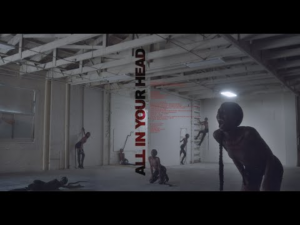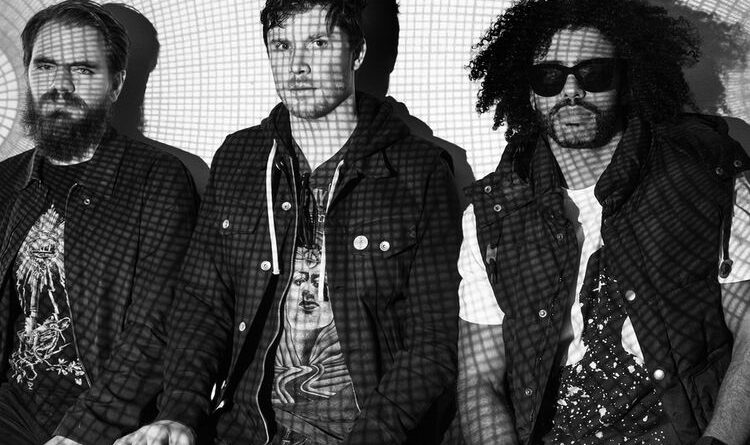Clipping’s music still scares me
Clipping is an experimental rap group, formed in LA in 2010, that specializes in industrial music. It is comprised of rapper Daveed Diggs and producers William Hutson and Jonathan Snipes.
Simply put, industrial music is characterized by harsh, abrasive, and often mechanical sounds. And Hutson and Snipes are masters of this genre.
There’s a great sense of physicality to their instrumentals, many of which sound like real world objects being manipulated in strange ways. The cover of their 2013 debut midcity is an image of scattered VHS tape, and that’s exactly what most of that album sounds like.
The production style is pretty one-note, often defaulting to static and distorted synths, but they’ve found plenty of ways to keep things interesting. One of the better songs on midcity is “bout.that,” whose main driving instrument is a sample of somebody choking. The skit “overpass” stretches a censor beep into a minute-long interlude.
The semi-self-titled album CLPPNG has a similar nature. The cover is a twisted metal fence, and while only some of the songs evoke that image, the whole album has the same shrill, piercing quality. The main sample of “Get Up” is an alarm clock beeping. “Tonight” is a parody of a club anthem about trying to “pull,” so to speak. It has this purposely generic and annoying beat, that eventually devolves into this hilarious verse about two drunk people trying to hook up; stumbling, knocking things over, etc..
This all sounds crazy, but I promise that much of their work reads as traditional rap songs, with hooks, verses, choruses, etc., all anchored by Daveed Diggs.
Most people know him from playing the roles of Thomas Jefferson and Marquis de Lafayette in the Broadway musical Hamilton. I wish he was able to parlay his Hamilton fame into more mainstream success, or choose a project with more broad appeal. Because I really do think that he’s one of the greatest rappers of all time, and doesn’t get the recognition he deserves. He almost exclusively writes about the visceral horror of living in modern urban environments. This ethos is summarized by the chorus of “Or Die” off of CLPPNG:
Everybody make a choice it is not profound,
either get money or die,
get faded or die,
get famous or die,
get your hands in the sky or get it between the eyes,
get money or die,
get money or die.

Diggs has a Sherlockian eye for detail. He does his best work when it takes you a minute to figure out he’s just describing a room, such as the crime scene featured in “Inside Out:”
Donald Duck, Sunny D,
Tampico, Caprisun,
orange couch, plastic wrap,
“What’s Happening” rerun.
Oak frame holograph Jesus portrait.
Brown shag carpet,
broken screen door to the back porch.
The tone is often dismissive and sarcastic, and it bleeds through in his descriptions of things, such as the song “bullshit;”
Umbrella on a drink, under an
umbrella on a beach towel
brought by a set of big tits for a tip.
Interchangeable Carribean island
high-end sandals striped feet, French tips
…
Rolex with more diamonds than gears,
ice sculpture inexplicably solid for years
Diggs is a strong storyteller when he wants to be. The simply named “Story” songs are scattered throughout their discography, and the band has promised that they’ll eventually connect into one long narrative. But right now, we only have the first, second, fifth, and seventh entries into the series.
The best of these so far is “Story 2,” which follows Mike Winfield, a reformed arsonist, whose own home meets the same fate that he’s inflicted on so many others.
Looks up in the sky, glow’s familiar
knows those families died with similar
awnings and on and on, he keeps going
hits the corner just as he hears the explosions
screams come from the house, “did you get them out?”
Mike asking the crowd that has gathered round.
It’s lyrically the darkest song I’ve ever heard, and it really makes you wonder how it could possibly connect to “Story 5,” a gospel song about Grace, a combat veteran who comes home to speak about her experiences.
On the nights when Grace would speak,
As the drunkards cursed and roared,
She’d tell tales of battles won,
And how she’d just begun,
Grace would help keep us safe at home.
When Diggs does decide to be explicitly political, it’s always with the same creativity and abstraction he applies to the rest of his music. Their most straightforward concept album, 2016’s Splendor & Misery, tells the story of a novice rapper being abducted by aliens and living on an abandoned interstellar cargo ship, a clear metaphor for the slave trade.
He sticks to this topic with the single “The Deep,” which riffs on the myth of Atlantis, telling the story of water-dwelling descendants of pregnant African women thrown off of slave ships. This song was nominated for a Hugo award, and the concept was eventually developed into a full-blown Afrofuturist novel by Rivers Solomon.
All of this– Diggs’ talent, the instrumentals, the subject matter– culminated in There Existed an Addiction to Blood, one of my favorite albums, and the only music that’s ever made me feel actual fear.
Addiction was deliberately released in late October of 2019, as it’s essentially an hour-long slasher flick in musical form. It’s their most dense, abstract, and inventive work yet. They make so many choices here that I still think about often. It functions as a series of vignettes connected by a theme, and I could gush about all fifteen tracks, but I’ll stick to the highlights.
The most esoteric track is the closer “Piano Burning,” which is literally just eighteen minutes of a piano burning. Like, an actual piano being set on fire in real life.
One of the most unsettling tracks is “Club Down,” about a night club getting shot up, which carefully distorts static to mimic people screaming. The lyrics here are oddly literate and classical:
Tut-tut, it looks like rain,
He remembers A.A. Milne each time
the sky’s this type of gray.
That or his favorite film,
Gene Kelly leaping
Technicolor through the fray.
“Run for Your Life” is a song about a man trapped in a back alley, hiding from a crazed woman who’s trying to kill him. The song is mostly ambient background noise, but you can hear the main beat come from passing cars, fading in and out periodically.
This album has a lot of femme fatales. “Story 7” follows Cynthia, a vampire who kills men after hooking up with them. Midway through the song, she meets Randy at the bar– a character from the first “Story.” When I first listened to this, I started pumping my fists in the air in excitement. I did this again when it’s implied that Grace from “Story 5” is Randy’s sister. The song ends with a vampire hunter shooting Cynthia and Randy with silver bullets.
“The Show” details some sort of underground art exhibition, where a body is being dissected in front of an audience. It’s unclear whether the crowd are willing participants, or whether this is meant to be taken at face value;
Don’t know which body part should go
first, spin the wheel vertigo
it’s an art you partake in and just know
you all paid to watch, so let’s start the show
The lead single “Nothing is Safe” is perhaps the most conventional song on the album. It creates a sense of dread, starting off with a single piano key, then naturally escalates until it bursts open with the first chorus. The lyrics describe a gunfight in a criminal safehouse, with our protagonist facing death right in front of him.
Long ago you summoned what was coming
it was creeping on the come up
now it’s right up in your face, face it
let it resonate up in your bone a minute
when you shiver make a sliver
big enough for it to have a space
“All in Your Head” comes towards the very end, and features the most hauntingly beautiful moment I’ve ever heard. The first half is Diggs and Robyn Hood delivering something close to spoken word poetry, over an instrumental that sounds like it’s being forged over an anvil, with consistent piercing hammer strikes. Then it abruptly stops, and singer/composer Counterfeit Madison starts singing gospel, over the hum of an amplifier. This vaguely orchestral melody starts to peak through, you don’t know where it’s coming from, but you know it’ll hit you soon, and it all gets louder and louder and explodes into this crescendo that’s difficult to translate over text. I don’t know what any of it is supposed to mean, but I know it left me reeling the first time I heard it.
And that’s the thing: Addiction achieves its desired effect the first time you hear it. They tried to replicate the effect with a direct sequel, Visions of Bodies Being Burned, released in 2020, but it doesn’t have the same conceptual draw (though I do love tracks like “Check the Lock” and “Enlacing.”) I’m a weirdo, so this has all made its way into my usual rotation, but objectively, it has very little replay value, and this will be a singular experience for the vast majority of people. And honestly? That’s enough.


